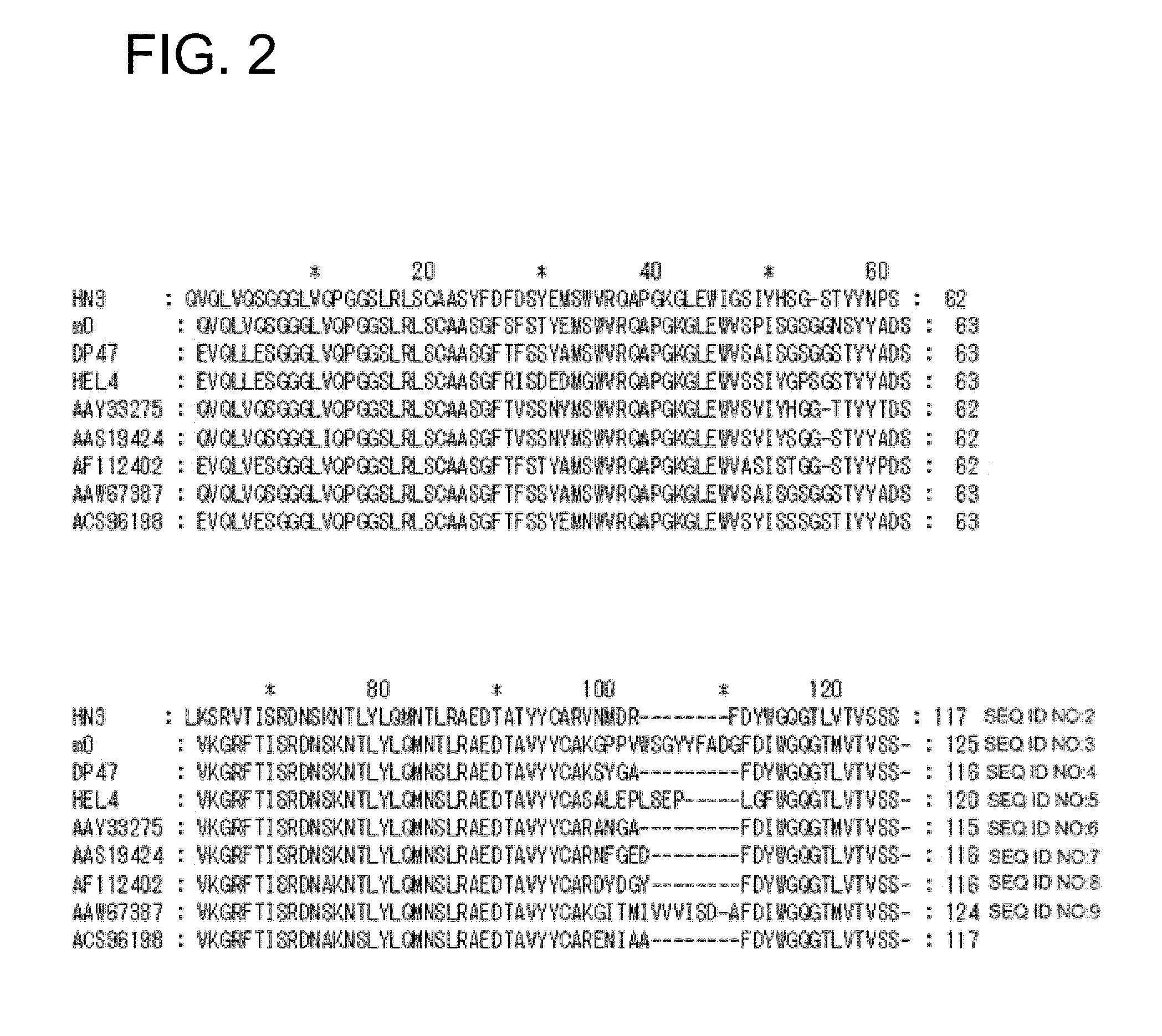Human monoclonal antibodies specific for glypican-3 and use thereof
a technology of glypican and monoclonal antibodies, applied in the field of human monoclonal antibodies specific for glypican3, can solve the problems of unreachable, poorly understood molecular mechanisms underlying tumor metastasis, etc., and achieve the effect of confirming the diagnosis of cancer
- Summary
- Abstract
- Description
- Claims
- Application Information
AI Technical Summary
Benefits of technology
Problems solved by technology
Method used
Image
Examples
example 1
HN3—a Human Single-Domain Monoclonal Antibody that Binds Cell Surface-Associated Glypican-3 and Inhibits HCC Cell Proliferation
[0266]This example describes the generation and characterization of a high-affinity single-domain mAb against tumor-associated GPC3.
A. Materials and Methods
Cell Lines
[0267]Human hepatocarcinoma cell lines HepG2, Hep3B, HuH-1, HuH-4, HuH-7, and SK-Hep lwere maintained as adherent monolayer cultures in D-MEM medium (Invitrogen, Carlsbad, Calif.) supplemented with 10% fetal bovine serum (HyClone, Logan, Utah), 1% L-glutamine, and 1% penicillin-streptomycin (Invitrogen, Carlsbad, Calif.) and incubated in 5% CO2 with a balance of air at 37° C. Cells were harvested and the media were changed twice a week. Cells were confirmed to be negative for mycoplasma. A431 (human epithelial carcinoma cell line), which is GPC3 negative cell line, was engineered to express high levels of GPC3 by transfection with a plasmid coding for GPC3. Both A431 and the stably transfected c...
example 2
HS20—a Human Monoclonal Antibody that Binds the Heparan Sulfate Chains on GPC3 and Inhibits Hepatocellular Carcinoma Cell Migration
[0293]This example describes the generation and characterization of a human mAb that binds heparin sulfate on GPC3.
A. Materials and Methods
Cell Lines
[0294]A panel of six human HCC cell lines (SK-Hep1, HepG2, Hep3B, Huh-1, Huh-4, and Huh-7) was obtained from the National Cancer Institute (NCI) Laboratory of Human Carcinogenesis, Bethesda, Md. A431 (human epithelial carcinoma cell line) was obtained from American Type Culture Collection (ATCC; Manassas, Va.). The cell lines were cultured in RPMI or DMEM supplemented with 10% fetal bovine serum, 100 U / mL penicillin, 0.1 mg / mL streptomycin, and 2 mmol / L L-glutamine. Cells were harvested and the media was changed twice a week. Cells were confirmed to be negative for mycoplasma.
Generation of a Human Cell Stably Expressing GPC3
[0295]A431 cells were transfected with the pReceiver vector containing a full-length...
example 3
Mutation of HS20 to Remove an N-Glycosylation Site does not Alter Binding Affinity and Specificity
[0318]This example describes modification of the H220 mAb to remove an N-glycosylation site identified in the VL domain.
[0319]Two light chains bands were observed in the HS20 IgG expressed in the HEK-293-based mammalian expression system, suggesting the presence of an N-glycosylation site. By analyzing the sequence of the light chain, a potential N-glycosylation site was identified in CDR2 of the VL domain of HS20 (amino acid residue 50 of SEQ ID NO: 16). The presence of the N-glycosylation site produced an extra band of approximately 30 kDa when analyzed by SDS-PAGE; however, a single band was observed when the purified HS20 IgG was treated with the endoglycosidase PNGase to remove all N-glycosylation (FIG. 15A). A Western blot of H2S0 mAb treated with PNGase also demonstrated a single VL band, while untreated antibody resulted in two bands for the VL domain (FIG. 15B).
[0320]To remove ...
PUM
| Property | Measurement | Unit |
|---|---|---|
| concentration | aaaaa | aaaaa |
| volume | aaaaa | aaaaa |
| dissociation constant | aaaaa | aaaaa |
Abstract
Description
Claims
Application Information
 Login to View More
Login to View More - R&D
- Intellectual Property
- Life Sciences
- Materials
- Tech Scout
- Unparalleled Data Quality
- Higher Quality Content
- 60% Fewer Hallucinations
Browse by: Latest US Patents, China's latest patents, Technical Efficacy Thesaurus, Application Domain, Technology Topic, Popular Technical Reports.
© 2025 PatSnap. All rights reserved.Legal|Privacy policy|Modern Slavery Act Transparency Statement|Sitemap|About US| Contact US: help@patsnap.com



